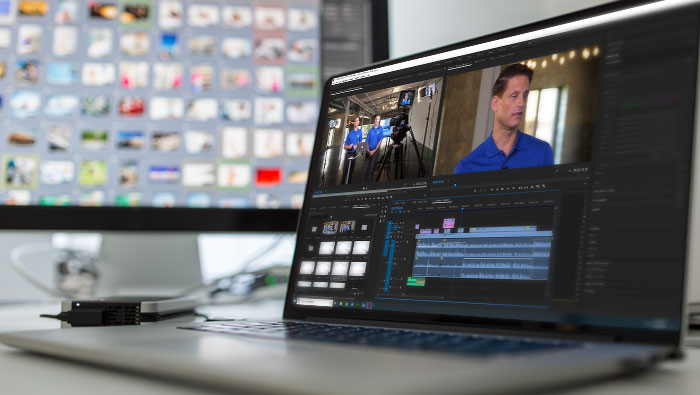
Often people are surprised when they learn that longest process of making a professional marketing or sales video often takes place after the video is shot. While you have pre-planning and the video shoot day, post-production is where the heavy lifting happens. Post-production includes editing, sound correcting (no more ums!), graphics and several other fine-tuning tricks that make a successful, beautiful video.
Video Upload, Organization: Once the crews get back to home base, they will upload the video footage to the computer. Depending on the amount of video shot and the quality (4K, 1080p, etc) of it, this could take several hours. Plus, when you upload, you have to organize the video into folders to make it easier to find when editing. When you categorize your footage, you’ll easily be able to find that exterior shot of the office when you need it.
Transcribing Soundbites: When the video upload is completed, the interviews need to be transcribed. This means, someone listens to the interviews and types out everything the person said. There are programs that will “transcribe” interviews for you, but it’s a good idea to listen to the interviews because sometimes you need to hear the way a person says something to see if it will work for your video. If you only look at the words on the page, you can’t tell how the person ends the sentence or if their comments are smooth. During transcribing, you must also take note of what time during the interview the person said the statement. You need to give this “timecode” to the editor; otherwise, the editor won’t know if your favorite soundbite is at the beginning or end of the interview. If you look at a video script, you’ll see timecoded notes such as: Sam 1:45:12-1:45:21 “Using this software changed our company’s marketing strategy.”
Writing a script: Once the interviews are transcribed and logged, the producer will write the script or storyboard. They will review all the interviews selecting the best part of each interview to tell a compelling story. They’ll creatively weave the interviews together to ensure the message is clear and meets the goal of the video. The script will have interviews put in order of how it will look on the video. There will also be cues for specific video shots or graphics that will need to be made.
The Edit: After the video script is approved, the editing begins. The editor will put together the video clips according to the script. Other elements of the video might include a voiceover, sound effects or music. For some of these elements you may have to hire out someone to do the voiceover, which includes finding a specific “voice” or “tone” that you think fits the video best. The editor also has to remove all of the “uhs and ums” out of the interview. This helps the person look and sound more professional, but it can be a tedious task. For each word or pause that is removed, you have to cover that portion with video footage.
Graphics or Visual Effects: Once the video portion is put together, graphics or other visual effects may be added. Creating graphics take several layers, especially if the graphics have movement or animation. If you’ve watched any news story, you have seen a “lower third” graphic. This is a graphic that is on the bottom “lower third” of the screen and often says the name and title of the person talking. When you edit a company’s story, you’ll need to build the graphics to match the brand standards.
Color Correction: When the video is put together and the graphics and visual effects are added, you do color correction. This is the process of matching the color and light, so each shot matches one another. Corrections include fixing white balance issues, where the color of the light doesn’t match. This step means the editor will go shot by shot to make sure it all looks good, which takes time.
Rendering: Once the editor is finished, the video will need to be rendered. This means all the layers of the video are molded together into one piece. Depending on the graphical elements in the video and the quality of the video, this could take a long time. A very short video can take 30 minutes to render. After rendering, the video must be exported to a standard video format such as a .mov or .mp4 file. Once the video is exported, then the editor can upload to a video sharing site like Vimeo for review and approval by the client. If the client makes any changes to the video, the entire process must be done again. One simple change of one shot may take an hour to complete by the time you fix the shot, render the file, export it and upload it.
Phew! Ok, now your video is complete! If the post-production phase seems complicated, that is because it can be. But, when done right, you will end up with a quality product you can be proud of.
*If you don’t have the right skills to get your video done, it’s always a good idea to look for help before you waste too much time trying to do it on your own. VideoEnvy provides full-service video production including concept, storyboard, shooting, writing, editing, graphics and media buying. Whether you need full-production or only a portion, our team is ready for you.
VideoEnvy @2024 | Telling Your Stories In Video. A Houston Video Production Company.